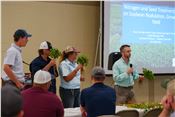Farmers Get Updates At AgCenter ‘Crops School’

LSU AgCenter soybean specialist David Moseley, right, displays soybean plant samples during a presentation on the use of nitrogen and seed treatments.
Photo by Olivia McClure/LSU AgCenter
OLIVIA MCCLURE
ALEXANDRIA, LOUISIANA
Late-afternoon thunderstorms forced the LSU AgCenter’s second annual Agronomic Crops School indoors – but farmers and others who came to the Dean Lee Research and Extension Center for the Aug. 4 event were still able to get updates on research projects and current crop issues.
The event normally would have included field tours of research plots.
Instead, AgCenter scientists brought their presentations and some crop samples from the field into the nearby State Evacuation Shelter to explain their work on management practices that could benefit farmers.
Agronomist Andre Reis discussed his study on growing soybeans on narrower rows – a practice that could lessen soil erosion and improve yields. Rows spaced 38 inches apart are common in Louisiana.
“But in the rest of the world, I’m used to seeing this kind of scenario,” Reis said, showing photos of much narrower configurations, such as 19-inch row spacings.
It takes longer for the soybean canopy to close over wider spaces between rows, meaning the soil stays exposed to the elements and is more prone to erosion. Narrower rows can help make more efficient use of land and offer greater yield potential, he said.
But transitioning to different row configurations in Louisiana could pose challenges. If rows are too close to one another, plants could stay too wet after rainfall and become stressed. Reis is investigating how narrow is too narrow and how wet is too wet.
Soybean specialist David Moseley stressed the importance of inoculating soybeans – particularly with Bradyrhizobium japonicum, a nitrogen-fixing bacterium – via seed treatments. The inoculant can help give a boost in root mass and yield.
“It is perhaps the most important management practice in soybean,” Moseley said.
He is studying how big of a difference inoculants along with nitrogen applications make in soybean growth, nodulation and yield.
Entomologist James Villegas said it’s crucial to properly identify insects causing problems in fields. Some species look similar but require different control strategies.
He also told producers to stay aware of insecticide resistance issues and to rotate chemistries to avoid building resistance.
Though it has been a light year for disease problems, plant pathologist Boyd Padgett said it is still important to remember what he calls the disease triangle: environment, pathogen and host, all of which contribute to disease development.
Each of these factors must be considered when trying to pinpoint the cause of an issue found in a field. Often, abiotic stresses cause symptoms that resemble signs of disease.
Weed scientist Daniel Stephenson displayed a series of photos of herbicide drift symptoms on various crops. He urged farmers to thoroughly clean their equipment and to always follow label directions.
Also, engineer Randy Price showed several types of drones and discussed their potential uses.
On the administrative front, Central Region director Tara Smith had good news to share with the crowd: the AgCenter is working to fill a fruit and nut specialist position. That will bring the total number of faculty members based at Dean Lee to nine, she said, adding that three of those are new hires made within the past year.
“I think you will see that we have hired some very talented faculty who have hit the ground running and are excited about addressing your needs,” she said.
Michael Salassi, AgCenter associate vice president, invited producers and others in the industry to offer their thoughts on how the AgCenter can best serve them.
“The most important thing you can give us is your input,” Salassi said, especially when hiring is underway for positions such as the specialist job.
The event was dedicated to Laura Lee, a Dean Lee research associate who died in a car wreck just a few days prior. Her colleagues recalled her vibrant personality and strong work ethic.
“She would energize anyone she was around,” Stephenson said. ∆
OLIVIA MCCLURE: LSU AgCenter